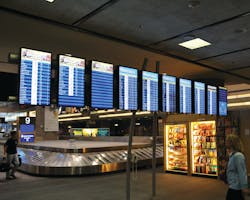According to the 2011 SITA Airport IT Trends Survey, respondents ranked 'improving customer service' as the primary driver for new technology investments. Says SITA, mobile services investments for passengers and staff continue to top the airport investment priority list.
The survey also suggests that almost six out of ten airports are planning major investments to upgrade existing IT infrastructure.
With regard to passenger processing technology, the survey shows that self-service continues to grow, and that airports plan to extend the self-service concept to other passenger touchpoints such as e-gate and common bag-drop functionality.
On the digital communications front, SITA's survey suggests that services on mobile devices and social networks are set to support the airport’s customer service vision.
"Notification of flight status and delays on passenger mobile phones remains at the top of airport mobile investments," states SITA. "Utilizing mobile phones to direct passengers around the airport is beginning to attract airport investments with 44 percent of respondents planning for such services by 2014.
"Airports also have a strong desire to offer retail services by way of the mobile device [60 percent with plans by 2014]."
With an increased focus by airports to provide a quality customer service experience for travelers coupled with the benefit of emerging digital display and passenger processing technology on operational efficiency, information technology (IT) is driving the business of customer communication and engagement at the airport setting.
Comments Derrek Wright, FlightStats director of business development for the airport segment, "Airports are moving towards an orientation of really optimizing the traveler experience. What traditionally was an IT approach with providing data to airports via FIDS screens has now expanded to the entire communication ecosystem within and around airports."
Says Sam Ingalls, assistant director of aviation, information systems, McCarran International Airport, "I’m very dead-set on business driving the technology, and not the other way around.
"In a general sense, my airport colleagues are really doing a lot of exciting things and moving forward. I’ve seen a groundswell of activity over the past few years, and a lot of uptake of the various initiatives and implementation of technology."
Dynamic display solutions
David Saleme, concessions manager for the Columbus Regional Airport Authority, has been with the Port Columbus International Airport for some 15 years.
Dynamic signage allows for frequency of impressions, flexibility, and creative content, relates Saleme. It’s a very good medium for the messaging we are putting out there with our different concessions; it allows a very high degree of flexibility with almost instantaneous ability to update content.
Because the pressure is on airports to enhance non-aeronautical revenue generation, Saleme says a good strategy is to combine content that informs the traveler with promotion and advertising offers.
"We look for that continual increase and the gross revenue sales, but what also helps us is the ability to employ combination-use hardware, so we are able to provide both flight information in the media proximity of the advertising," explains Saleme. "We are able to provide the information the passenger is looking for while recouping some of the investment of that display installation with advertising opportunities."
Adds Engalls, "The ability to dynamically display whatever it is you may need to display in any part of the terminal at any point in time is an incredible advantage.
"Whether it's LED or LCD, we have some 1,300 dynamic signs in Terminal 3 and, excluding the FIDS, some 400 in Terminal 1 and Terminal 2 currently.
"We have really fine-tuned our process with the dynamic signs, and it really gives us a lot of flexibility to drive messaging to different parts of the terminal building, and provide information to customers that we couldn’t do in a static sense."
With regard to the future of signage technology, Saleme says we will continue to see a growth in the use of large format digital media. Designing advertising that catches the eyes of customers is important; large format digital media does that, he relates. "The larger the format - the more attention grabbing it is, and able to communicate the message more effectively.
"There will continue to be an increase of interactive technology incorpoated into digital displays," adds Saleme. "People are becoming very accustomed to interacting with the touchscreen, whether its an iPhone, iPod, or Android device … touch technology is going to continue to become more prevalent at the airport setting."
Information distribution; social media
"We are quite interactive in social media; it enhances our ability to directly interact with our customers, and to personalize the experience," remarks Ingalls. "We really do try to provide a personal customer service experience where we are able to do that. Using various forms of digital communication to push information out to customers in real-time in a great benefit."
Ingalls has participated on many airport technology standard-setting groups; currently, there are several areas the groups are working on related to the passenger processing experience.
"There are a lot of capabilities for direct interaction with the customer," says Ingalls. "There are so many different channels now; that’s what’s so exciting about what technology has brought us in terms of the capability for a direct communication link to the customer or end-user."
Keith Gerr, marketing director with FlightStats, says the company has been zeroing in on the fact that airports want to deliver a great customer service experience. "There are some big themes we roll out with, one of them being the ability to provide data consistency across all customer touchpoints."
FlightStats tries to weave a combination of consumer products along with its FlightStats.com website and additional products that an airport can purchase, such as data feeds, as a way provide data consistency to airport partners, says FlightStats' Wright.
"Think about FlightStats as a network," explains Gerr. "We have the website, apps, data relationships; our Airport Portal service allows airports to view us as an extension of their brand; that is an objective of ours."
Adds Scott Hopkins, product development for the airport segment at FlightStats, "Our fundamental goal is, we have a huge traveling consumer base, and we want to be able to connect airports with that traveler base.
"One of the areas that airports are really interested in is getting offers into the hands of travelers, such as for concessions or parking; we are still in an exploratory phase on that functionality."
Passenger processing; customer service
"We have seen huge benefits from common use technology over the years … I can’t tell you what that’s meant to us both economically and operationally," says Ingalls.
When you get down to the customer service level, common use should be transparent to the customer, he adds.
With regard the ability to check-in online, technology and the function of IT at the airport starts for many travelers before reaching the terminal. "Technology that enables paperless boarding; self-bag tagging; express and remote bag-drops; online check-in; mobile information delivery … all of that is going to continue to increase at the airport setting, and make facilities more operationally efficient," explains Ingalls.
McCarran has been trialing self-boarding technology; carriers have been sharing a couple self-boarding gates. "When we open our new terminal building," says Ingalls, "all gates will be outfitted and equipped with self-boarding functionality.
"We are also putting in kiosks in the new terminal building that can support self-bag tagging. Bag-drop functionality is really going to be key; I think that process will skyrocket in terms of usage across the U.S. as it rolls forward out of what has been very limited pilot-type activity."
On customer service, Ingalls says McCarran has provided complimentary Wi-Fi since January 2005, and initially that was a customer service item. "We have earned a considerable amount of revenue through sponsorship and other types of arrangements related to the Wi-Fi service. To me, that’s a great example of having your cake and eating it to – providing the experience to the customer while still earning the revenue.
"We provide free Wi-Fi services throughout all terminal facilities, and we will have more than 10,000 users connect in a given day.
"This is all about empowering the customer; they have the technology in their hands. Airports must continue to put the power of process in the travelers' hands."
Ultimately, Ingalls relates that business should be driving the technology — whether its passenger processing or social media — both in terms of the ultimate benefit to the customer, and in terms of the economic and financial benefit to the airport and its partners.
"It was just prior to moving forward with common use some 15 years ago, we actually commissioned a very extensive technology master plan," remarks Ingalls. "We have updated that since and I think there are a lot of other airports that have done that as well.
"Technology is becoming a much more integrated part to the master planning process for airports, and it should be."
FlightView Gate-Side Survey Highlights
FlightView, a provider of real-time flight information solutions for the aviation and travel industries, recently conducted a gate-side survey at four major U.S. airports - Boston Logan, Denver, San Diego, and Myrtle Beach.
The survey found that 62 percent of travelers are frustrated when they’re at the gate, learn that their flight has been delayed, and can’t get enough information on a new take-off time.
Airports and airlines can provide more detailed information for a delayed flight with gate displays that visually show passengers where their plane is located, and when it’s expected to arrive, says FlightView.
Perfecting mobile content
Airports and airlines have an opportunity to improve customer service by moving beyond just offering flight status information on mobile websites and apps - to providing information such as nearby amenities, boarding messages, upgrade information, social sharing functionality, and other day-of-travel information, according to FlightView.
Tapping the cloud
Limited resources and an increased pressure to ensure that flight information is up-to-date, accurate, and always available will fuel more airports and airlines to enlist third-party cloud providers to manage, host, and distribute flight information. This will resulte in more reliable travel information at a lower cost, says the company.
More information on the results of FlightView's gate-side survey can be found on the Web at: flightview.com/corporate/news.
Near Field Communication Technology
SITA Lab, the technology research arm of IT provider SITA, working on a joint innovation program with Orange Business Services, a communications services partner, has shown that passengers could use a near field communication-enabled (NFC) phone as a boarding pass to open security, airline lounge, and boarding gates automatically.
Airport equipment providers DESKO and Kaba also joined SITA and Orange in the development of the pilot, providing advanced scanners, readers, and security access gates.
According to a press release, NFC allows smartphones and similar devices to communicate with each other. NFC-enabled smartphones can hold secure information such as credit card data, or passenger data inclu,ding boarding passes and identities; they can also be used for contactless transactions such as payment or airline boarding.
Because NFC is short range and also supports encryption, it ensures the transactions are secure. With all the major phone producers adding NFC-enabled devices to their ranges, this technology is set to become an important new way for passengers to use smartphones at the airport, according to SITA.
An International Air Transportation Agency whitepaper titled, The Benefits of Mobile NFC for Air Travel, states that NFC represents a new wave of mobile innovation enabling a wide range of new services.
According to IATA, NFC is an enabling technology that allows performing transactions in a simple movement with a mobile phone. Unlike other technologies such as Bluetooth, the transaction is performed in a voluntary gesture, in full respect of data privacy.
Six different use cases have been defined where mobile NFC can bring benefits to airlines, airport authorities, and travelers:
- Passenger check-in;
- Baggage check-in;
- Security check-point;
- Lounge access;
- Boarding; and
- Post-flight.
A short animated demo of NFC can be found on the Web at: www.sita.aero/content/near-field-communications-demo.
About the Author

